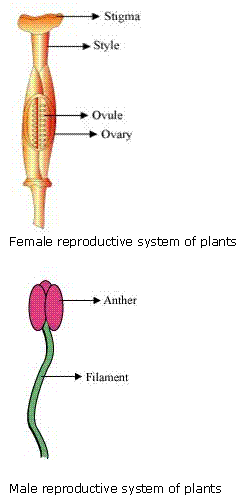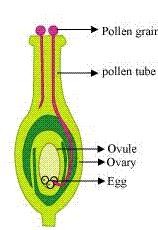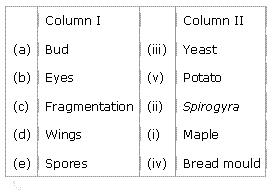Class 7 NCERT Solutions Science Chapter 8 - Reproduction in Plants
Reproduction in Plants Exercise 90
Solution 1
(a) vegetative propagation
(b) Unisexual
(c) Pollination
(d) Fertilization
(e) Wind, water and animals
Concept insight: Important from Exam Point of View.
Solution 2
The various modes of asexual reproduction in plants are as follows:
(i)Vegetative propagation: It is the ability of a plant to produce new plants from vegetative parts of the plant like roots, stems, leaves, and buds. Vegetative propagation is divided into two types.
a. Natural vegetative propagation: This type of vegetative propagation occurs easily in nature and involves simple vegetative parts. Potato plant sprouting from an eye is a common example.
b.Artificial vegetative propagation: This type of vegetative propagation is performed manually and generally occurs in laboratory conditions. The formation of a complete plant from a stem cutting of rose is a common example of this method.
(ii) Budding:It involves the formation of a new individual from a bulb-like projection called a bud. The bud grows and gets detached from the parent to form a new individual. It is commonly observed in yeast.
(iii)Fragmentation:It is a form of asexual reproduction where a new organism is formed from the fragments of the parent body. It is the only mode of asexual reproduction in Spirogyra.
(iv)Spore formation:Many non-flowering plants reproduce through spore formation. Spores are tiny cells protected by a thick wall. Fungi such as bread moulds reproduce asexually using this method.
Concept insight: List the various methods of asexual reproduction.
Solution 3
Sexual reproduction is a process which involves the production of seeds in plants. It requires two parents. Most plants reproduce sexually with the help of flowers. Through this process new organisms are produced which are almost similar to their parents.
Concept insight: Recall the definition of sexual reproduction in plants.
Solution 4
Differences between sexual and asexual reproduction:
|
Asexual reproduction |
Sexual reproduction |
|
i. It requires only one parent. |
i. It requires two parents. |
|
ii. In asexual reproduction, newly developed plants are identical to the parent and to each other. |
ii In sexual reproduction, newly developed plants are similar to their parents.
|
|
iii. Special reproductive parts are not required for asexual reproduction. |
iii. Flower is the reproductive part of a plant which contains the sexual organs of a plant. These are important for sexual reproduction. |
|
Examples are yeast, rose, jasmine, potato, etc. |
Examples are flowering plants, such as Hibiscus, corn, papaya, etc. |
Concept insight: List the differences between asexual and sexual reproduction.
Solution 5
Concept insight: Pistil is the female reproductive part of a flower and stamen is the male reproductive part of a flower.
Solution 6
Differences between self-pollination and cross-pollination:
|
Self-pollination |
Cross-pollination |
|
i. It involves the transfer of pollen from the stamen to the pistil of the same flower. |
i. It involves the transfer of pollen from the stamen of one flower to the pistil of another flower of the same plant or that of a different plant of the same kind. |
|
ii. It occurs only in bisexual flowers. |
ii. It occurs in both unisexual and bisexual flowers. |
Concept insight: List the differences between self-pollination and cross-pollination.
Solution 7
After pollination, pollen grain develops a pollen tube which passes through style to the ovule. Pollen tube carries male gametes to the ovule. Through micropyle it enters in the ovule where one male gamete fuses with female gamete to form zygote. This process of fusion of male and female gamete is called fertilization.
Fig: Longitudinal section of flower showing fusion of male and female gametes
Concept insight: Recall the process of fertilization in plants.
Solution 8
Seed dispersal occurs by the following agencies:
(a)Dispersal by animals - There are many ways by which birds and animals can disperse seeds. For example, birds and animals can eat the fruits and excrete the seeds away from the parent plant. Some seeds have barbs or other structures that get attached to the animal's body and are carried to new sites. Some fruits have hooks on them which cling to fur or clothes. Example - Xanthium.
(b)Dispersal by wind - Seeds that get dispersed by wind are usually smaller in size or they have wings or hair-like structures. For example, winged seeds of drumsticks, hairy fruit of sunflower, etc. are dispersed by wind.
(c)Dispersal by water - Many aquatic plants or plants that live near water has seeds that can float and are carried away by water. For example, coconuts can float and are dispersed by water.
(d) Dispersal by explosion - Sometimes the seeds are dispersed by the bursting of fruits with sudden jerks. The seeds get scattered or distributed far from the parent plant. Examples of such plants are castor and balsam.
Concept insight: List the various agencies by which seeds are dispersed.
Solution 9
Concept insight: List the modes of asexual reproduction in plants.
Solution 10
(a) The reproductive part of a plant is the
(iv) flower
(b) The process of fusion of the male and female gametes is called
(i) fertilization
(c) Mature ovary forms the
(iv) fruit
(d) A spore producing plant is
(ii) bread mould
(e) Bryophyllum can reproduce by its
(ii) leaves
Concept insight: Important from Exam Point of View.




